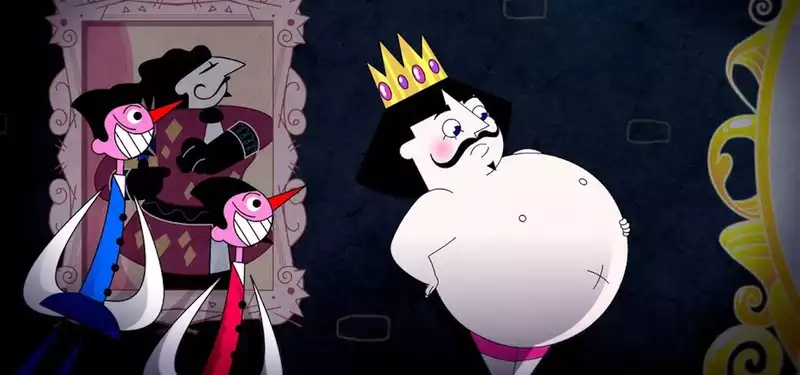Nov 20, 2019
How Did They Do It? Playing with Music and Geometry "The Emperor's Latest Clothes
Hans Christian Andersen's devilish tale "The Emperor's New Clothes" unfolds with a playful conceit. No one, least of all the emperor himself, addresses the emperor as he parades naked through his kingdom for fear of being ridiculed.
Perhaps because of the breadth of its visual gameplay, "The Emperor's New Clothes" has proven over the decades to be a fascinating work for filmmakers, including animators. When Simon Wilches Castro was given the chance to add a makeover to the story, he jumped at it.
The result is "The Emperor's New Clothes," a bold work that is characteristic of this Colombian-born artist. This half-hour special, which debuted on HBO last November, revels in the absurdity of the story: Wilchez Castro tells this tale with bubblegum colors and loud, angular designs. The eye-popping visuals are a perfect match for the high camp feel of William Finn's original music.
Below, the director guides Cartoon Brew through the myriad influences on the film's design. His comments were edited from a lengthy response sent via email. Although Wilches Castro is based in Titmouse, "The Emperor's Latest Clothes" was produced at Starburns Industries.
Wilches Castro The restriction of creating characters framed by simple geometry was a very interesting challenge, both in design and in animation. We strongly wanted them to express their unique personalities and "move" in a way that was specific to their shapes.
The emperor's body shape was supposed to indicate a life of excess and comfort and to show the attitude of a delusional person who believed himself to be a Greek statue. His legs and arms were disproportionate to his body size, making his movements short, clumsy, and awkward. This made for very interesting animation in his big dance numbers.
Tomasina was designed to be the opposite of the emperor. She is petite and seemingly helpless, which makes her eventual victory over the emperor all the sweeter. She is the most traditionally animated of the characters. Her movements express that she is the only sane person in this mad kingdom.
Syco, the clown, and Phantic, the military advisor, are designed to be visually opposing characters but united in their remorselessness; Syco was inspired by Alexander Calder's mobiles, while the stiff and dull Phantic was inspired by Japanese tangram games; the two had to match their designs as one strange mutant to perform together in a musical number, and the puzzle was a lot of fun to solve.
The tailor came in last. After coming up with the main cast, I was almost out of ideas, so exhausted I decided to just draw their profiles. Big eyes, big smiles, hair like shark fins. I always wanted a legible silhouette, so I detached their limbs from their bodies and gave them a sleek movement when Richard Ramos animated them. These two characters became the show's most popular designs.
Wilches Castro Once the characters and the general aesthetic of the film were decided upon, Galen Pehrson came in as art director to help create the world. It was a great challenge because we had to create something that made sense and something that didn't at the same time. His challenge, led by such talented designers as Simon Estrada, Ilana Schwartz, and Sullivan Brown, was to design an upside-down kingdom inspired by medieval art, where perspective is used selectively and irreverently.
Since the film was about "truth" and "facts," I wanted to create a world that did not attempt to represent photographic realism." Instead of "the illusion of life," we were trying to pursue "the disillusionment of modernity. We wanted to make it seem surreal, cubist, and sometimes nonsensical, so as not to be disbelieved. I drew inspiration from the Bauhaus artists: Kandinsky, Klee, and especially Oskar Schlemmer.
Wiljes Castro Another very unique aspect of this project was the constant back and forth between music and visuals. William Finn's music inspired the initial visuals, and composer Michael Starobin arranged the songs to reflect the temperament of each character. From these arrangements, animators Luke Freitag, Lars Ingleman, and Ramos devised choreographies based on the songs that were tailored (no pun intended) to each character's design.
Composing these musical numbers was one of the most fun things I had to do. I wanted to overlay the Broadway quality of Finn's songs with the stylized visuals of our design schema and see what came out. I am a big fan of Busby Berkeley and his work is as graphic and striking as Bauhaus work. I also made various references to "Yellow Submarine," one of my favorite films.
Sycophantic's music was most interesting to animate. Inspired by the "Elephants on Parade" sequence from "Dumbo," I wanted to create this "nightmare" as an improvised collage. There was no storyboard or proper animatic. I just had a library of assets to place linearly to the music and see what came out. I don't know if it worked, but it was undeniably unique, creative, and very fresh.
.



Post your comment